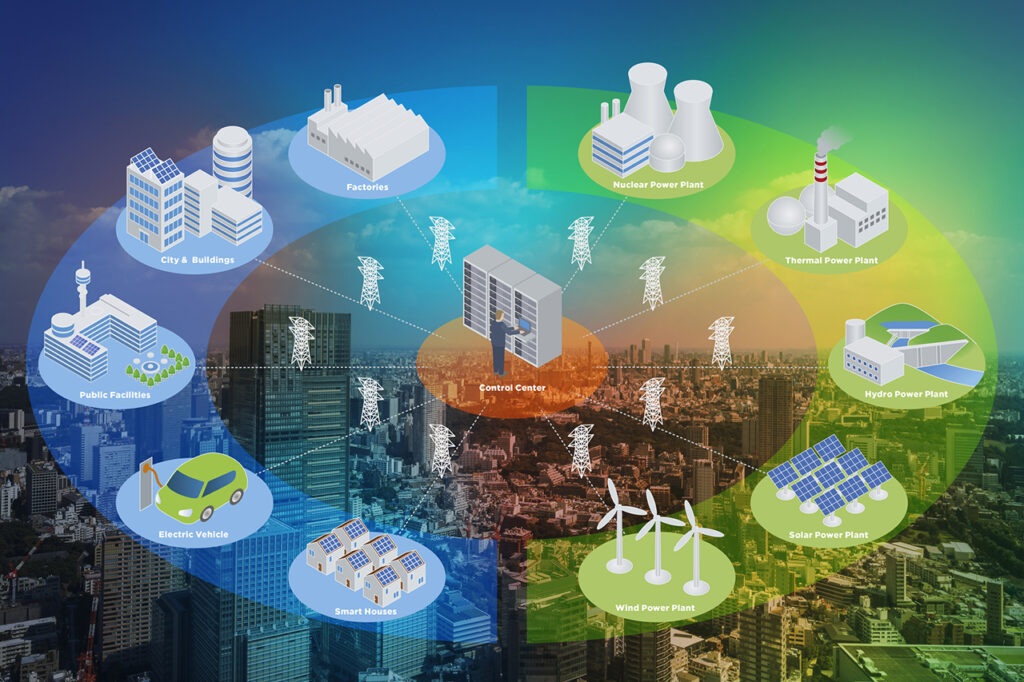In the era of rapid technological advancement and increasing energy demand, the traditional power grid is facing significant challenges in meeting the evolving needs of consumers, utilities, and society as a whole. Enter smart grid solutions—a transformative approach to modernizing and optimizing the electric grid through the integration of advanced technologies, data analytics, and two-way communication systems. In this article, we delve into the concept of smart grid solutions, exploring their benefits, applications, and the pivotal role they play in shaping the future of energy.

source: Digi International
At the core of smart grid solutions lies the concept of grid modernization, which involves upgrading and enhancing the infrastructure of the traditional power grid to make it more resilient, efficient, and adaptable to changing conditions. One key component of grid modernization efforts is the integration of advanced metering infrastructure (AMI), which enables utilities to collect real-time data on energy consumption, voltage levels, and grid performance. By deploying smart meters throughout their service territories, utilities gain valuable insights into electricity usage patterns, identify opportunities for energy conservation, and optimize grid operations.
Moreover, smart grid solutions leverage advanced communication and control technologies to enable two-way communication between utilities and end-users, as well as between different components of the grid itself. This bi-directional communication capability allows for dynamic load management, demand response programs, and grid optimization strategies that enhance grid stability and reliability. For example, utilities can use smart grid solutions to remotely monitor and control electrical transformers, adjusting voltage levels as needed to optimize grid performance and minimize energy losses.

source: ua-energy.org
Additionally, smart grid solutions enable the integration of renewable energy resources, energy storage systems, and electric vehicle charging infrastructure into the grid. With the growing adoption of solar panels, wind turbines, and other distributed energy resources (DERs), utilities are faced with the challenge of managing intermittent generation and balancing supply and demand in real time. Electrical transformers, as essential components of the power distribution system, play a crucial role in facilitating the integration of renewable energy into the grid by stepping up or stepping down voltage levels as needed to match load requirements.
Furthermore, smart grid solutions empower consumers to actively participate in energy management and conservation efforts through the use of advanced energy management systems and home automation technologies. By providing consumers with real-time information on energy usage, pricing, and grid conditions, smart grid solutions enable them to make informed decisions about their energy consumption and take advantage of time-of-use pricing schemes, demand response programs, and other incentive mechanisms to reduce their energy bills and contribute to grid stability.
Moreover, smart grid solutions enhance grid resilience and reliability by enabling proactive maintenance, fault detection, and outage management capabilities. By deploying sensors, monitoring devices, and predictive analytics tools throughout the grid, utilities can identify potential issues before they escalate into major problems, prioritize maintenance activities, and respond quickly to emergencies. This proactive approach to grid management helps minimize downtime, improve service reliability, and enhance overall grid performance.

source: utilityanalytics.com
Furthermore, smart grid solutions enable utilities to improve asset management practices and optimize the lifespan and performance of critical grid infrastructure. By leveraging data analytics, predictive maintenance algorithms, and condition monitoring technologies, utilities can identify potential issues with electrical transformers and other assets before they lead to costly failures or outages. Proactive maintenance strategies, such as asset health assessments and remote diagnostics, enable utilities to schedule maintenance activities more efficiently, reduce downtime, and extend the lifespan of their equipment.
Moreover, smart grid solutions support the integration of microgrids and decentralized energy systems into the broader electric grid. Microgrids are localized grids that can operate independently or in conjunction with the main grid, providing greater resilience, reliability, and flexibility to communities, campuses, and industrial facilities. Electrical transformers play a critical role in connecting microgrids to the main grid and managing power flows between different energy sources and loads. By enabling the seamless integration of microgrids into the grid infrastructure, smart grid solutions enhance energy resilience and support the transition to a more decentralized and resilient energy system.
Additionally, smart grid solutions facilitate grid optimization and congestion management through the use of advanced grid analytics and optimization algorithms. By analyzing real-time data on energy supply, demand, and grid conditions, utilities can identify bottlenecks, optimize power flows, and alleviate congestion in the grid. Electrical transformers equipped with advanced control and monitoring capabilities enable utilities to dynamically adjust voltage levels and power flows to optimize grid performance and maximize efficiency.

source: utilitymagazine.com.au
Furthermore, smart grid solutions enable utilities to enhance customer engagement and satisfaction through the provision of personalized energy services and innovative pricing schemes. By providing consumers with access to real-time energy usage data, energy-saving tips, and interactive tools, utilities can empower them to make more informed decisions about their energy consumption and participate in energy conservation efforts. Additionally, smart grid solutions enable utilities to offer flexible pricing options, such as time-of-use rates and demand response programs, that incentivize consumers to shift their energy usage to off-peak hours and reduce strain on the grid during periods of high demand.
Finally, smart grid solutions play a crucial role in supporting the electrification of transportation and the integration of electric vehicles (EVs) into the grid. As the adoption of EVs continues to grow, utilities are faced with the challenge of managing the increased electricity demand from charging infrastructure while ensuring grid stability and reliability. Electrical transformers, as essential components of the power distribution system, enable utilities to support the deployment of EV charging stations and manage the impact of EV charging on the grid. By leveraging smart grid solutions, utilities can implement smart charging strategies, manage grid congestion, and optimize the integration of EVs into the broader energy ecosystem.
In conclusion, smart grid solutions represent a paradigm shift in the way we generate, distribute, and consume electricity, offering a path towards a more sustainable, efficient, and resilient energy future. By leveraging advanced technologies, data analytics, and two-way communication systems, smart grid solutions enable utilities, consumers, and other stakeholders to collaborate in optimizing the performance of the electric grid. Electrical transformers, with their critical role in voltage regulation and grid optimization, are key enablers of smart grid solutions, facilitating the integration of renewable energy resources, demand response programs, and other grid modernization initiatives. As we continue to embrace smart grid solutions, we move closer to realizing the vision of a cleaner, more reliable, and more sustainable energy system for generations to come.



